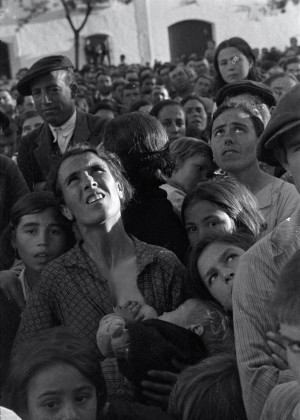David “Chim” Seymour – The Invisible Man
David “Chim” (pronounced shim, from his surname Szymin) Seymour was born on November 20, 1911 in Warsaw, Poland to parents of Polish-Jewish descent. Forty-five years later, killed while covering the Suez Canal armistice, he had become perhaps the most loved and respected photojournalist of his time. But he was a modest man. Commenting on one of his pictures, he said that all he needed was “a little bit of luck and enough muscle to click the shutter.”
The International Center of Photography’s current exhibit, We Went Back: Photographs from Europe 1933-1956, is a fitting tribute to one of the most important photographers of the 20th century. Curator Cynthia Young tells us in ICP’s and DelMonico Books/Prestel’s finely rendered publication of the show that the great photographer “wants to be invisible, in order to capture the world as it is.”
That’s a big order, even for a man like Chim. What he did capture in his subjects was their trust, and in many of his best pictures, the very heart of humanity. To understand the motivation of such a man better, we can look briefly at how the early world he inhabited formed him.
Immigrating to Odessa at the outbreak of World War I, Chim’s parents, part of a highly intelligent publishing family for Yiddish and Hebrew literature, returned to Warsaw in 1919. Graduating from Leipzig in 1931, it was Chim’s move to Paris to study at the Sorbonne that became a life-changing event. Paris was the City of Light in more ways than one, and when the owner of Rap, a pioneering photo agency, loaned Chim a camera, the magic of light through a camera’s lens captivated his heart. One of his first photo essays of night workers was inspired by George Brassai’s Paris de Nuit series from 1932.
Display cases handily placed for our perusal show a slight, almost impish man, hiding behind a pair of heavy-framed glasses that gave him an owlish look to observers. But appearances can deceive. This was the same man who covered the Spanish Civil war, who documented the Spanish war refugees on their way to Mexico, who was the first to publish in Regards, Ce Soir and Voila, who co-founded Magnum Photos along with photojournalists Robert Capa and Henri Cartier Bresson, and who traveled exhaustively throughout the Post WWII landscape to capture refugee children amidst the rubble and ruin. An entire wall of the exhibit is devoted to his magazine covers, and helps to give the viewer a sense of this cameraman’s relationship to time’s passing.
It’s no exaggeration to say that the founding of Magnum in 1947 defined a renewed sense of purpose for photographers like Chim, haunted by the visions of wartime (Chim had lost his own parents to the Nazis in 1942, while he was serving in the U.S. Army). Representing an idiosyncratic mix of reporter and artist, Magnum emphasized the necessity of telling a story worth remembering.
Arranged in chronological order, his pictures give a clear sense of his early talents at composition. One of the first photo groupings are his 1930s portraits of Brittany fishermen and their daily lives. In Line of tuna on a dock, Concarneau, Brittany, the silvery bodies of the day’s catch quickly grab at the viewer’s eye while Chim’s lens has cleverly caught dead-on the shining eyes of the fish themselves. Another unforgettable shot, A Catholic Pardon Ceremony at Sainte Anne, La Palud, shows three women sitting on the grass. One glances into the lens, while the others look askance, trying not to notice. Posed in patient resignation — their black umbrellas splayed open on the grass in front of them, white conical hats pointed skyward — they appear to await, one can only presume, some form of benediction. Workers in a Bar, Brittany, 1935, shows the aftermath of hard labor, with one fatigued, beret-topped subject staring deadpan into the camera’s eye. It’s the numbness that stirs the viewer, as if the man behind the camera wasn’t there at all.
There’s a generous sampling of crowd scenes — striking workers, for example, dressed in skirts and bras in bawdy defiance of authority; and a land reform meeting near Extremadura, Spain, including a mother nursing her baby in the midst of the crowd. Chim even managed to seek out Picasso, posing him under Guernica, his own immortalized painting of the horrors of the Spanish Civil War. In a later section, a group of silent onlookers gather at the Buchenwald trials — but it’s the individual that held his hand and heart steady. In a solitary 1951 portrait of an Italian immigrant in her newly-adopted country of Israel, the ravages of war are indelibly drawn on her face. Only the lens of a Walker Evans chronicling farmers in the aftermath of Oklahoma’s Dustbowl in the ’30s can compare.
(Article continued on next page)











